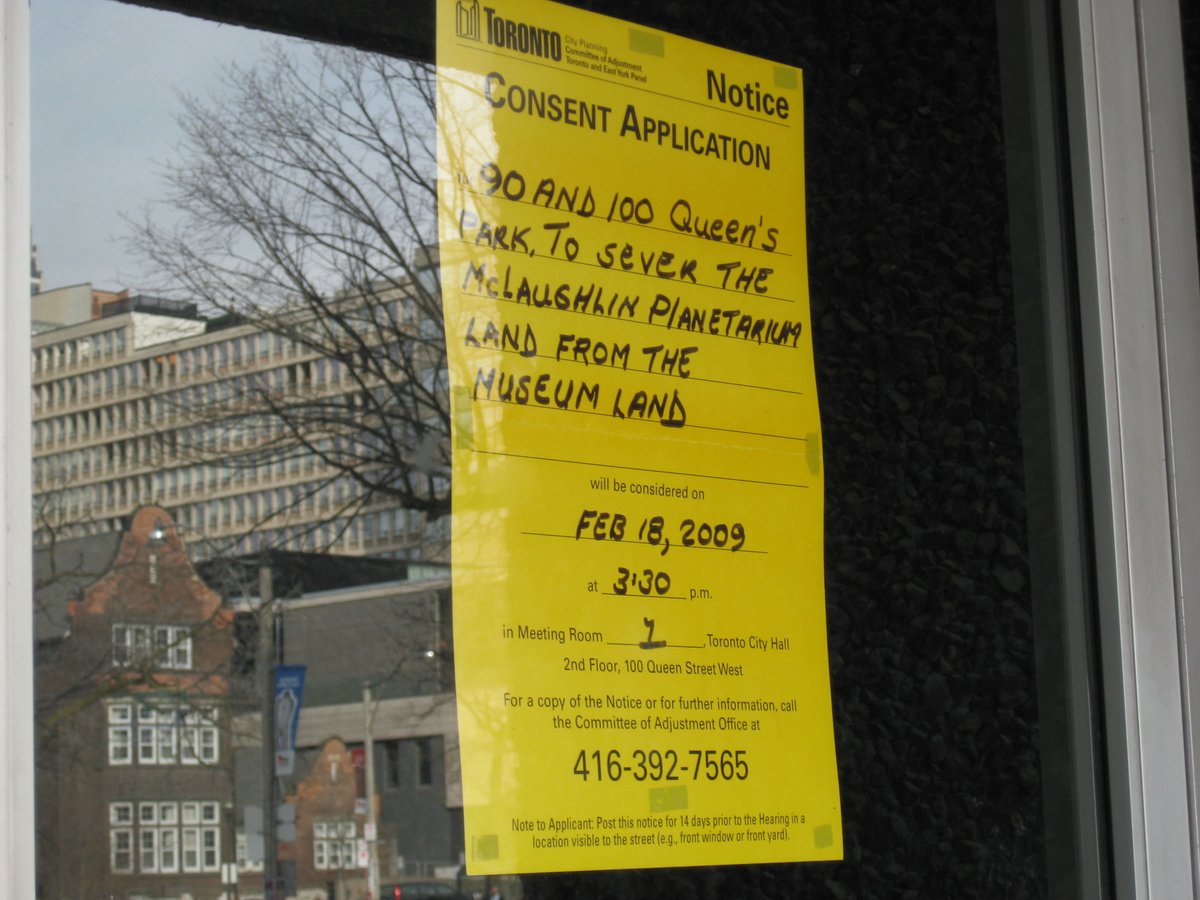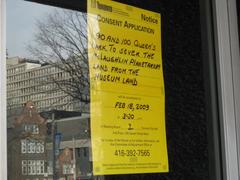
McLaughlin Planetarium Toronto: Visiting Hours, Tickets, and Visitor Guide
Date: 15/06/2025
Introduction
The McLaughlin Planetarium was once a beacon of astronomical education and cultural engagement in Toronto. Since its closure in 1995, the building has remained closed to the public, but its legacy endures in the city’s science heritage. This guide presents an in-depth exploration of the planetarium’s history, significance, and current alternatives for astronomy enthusiasts in Toronto. It also offers practical visitor information, highlights nearby attractions, and outlines ongoing efforts toward a new planetarium in the city.
Table of Contents
- Introduction
- Origins and Founding Vision
- Architectural and Technological Innovation
- Programming and Public Engagement
- Closure: Causes and Aftermath
- The Legacy of the McLaughlin Planetarium
- Visiting Today: Alternatives and Travel Tips
- Future Prospects for a New Planetarium
- Frequently Asked Questions
- Summary and Visitor Tips
- References and Further Reading
Origins and Founding Vision
The McLaughlin Planetarium was established through the philanthropy of Colonel R. Samuel McLaughlin, then-Chairman of General Motors of Canada, who donated over $3 million for its creation and endowment (Alternavox, MUSSA). Inspired by the Hayden Planetarium in New York, McLaughlin envisioned a world-class educational facility in Toronto. The University of Toronto contributed land, and the Royal Ontario Museum (ROM) provided institutional support, resulting in the planetarium’s strategic location at 90 Queen’s Park Crescent, adjacent to the ROM and the University of Toronto (MUSSA).
Architectural and Technological Innovation
Designed by Allward & Gouinlock, the McLaughlin Planetarium reflected the optimism of the space age. The striking dome—23 metres (75 feet) in diameter—housed a Zeiss-Jena electro-mechanical projector with 150 individual projectors, capable of simulating celestial phenomena with remarkable accuracy (RASC). The building featured four levels:
- Basement: Lecture hall and storage
- Ground Floor: Gift shop, library, coat check, staff lounge, and a bronze bust of R.S. McLaughlin
- Second Floor (Astrocentre): Interactive astronomical exhibits and workshops
- Third Floor (Theatre of the Stars): Main dome theatre, seating 361
Innovative for its time, the planetarium’s technology allowed audiences to experience the night sky from any place and time on Earth, and its auxiliary projectors could recreate phenomena such as auroras and spacecraft trajectories (RASC).
Programming and Public Engagement
From 1968 to 1995, the McLaughlin Planetarium was a hub for public science education. Its programming included:
- Family-Friendly Astronomy Shows: Presentations exploring the solar system, constellations, and space travel
- Special Themed Events: Holiday shows and advanced lectures on topics like cosmology and mythology
- Laser Light Concerts: Infamous evening shows synchronized to music by Pink Floyd, Genesis, and Led Zeppelin, which became a mainstay of Toronto’s nightlife (ThatEricAlper)
- Workshops and Hands-on Activities: Including lens grinding and telescope making
The planetarium also boasted a library and sales desk, making science resources accessible to a broad audience (RASC).
Closure: Causes and Aftermath
Despite its popularity and reputation as one of the few profitable planetariums in North America, the McLaughlin Planetarium closed on November 5, 1995 (Wikipedia). The closure resulted from a combination of factors:
- Provincial Budget Cuts: Under Premier Mike Harris, the Ontario government reduced funding to the ROM, which oversaw the planetarium (Storeys)
- Shifting Government Priorities: Emphasis on immediate spending reductions
- Operational Costs: The ROM saved an estimated $600,000 annually through closure (Erica Journo)
After closing, the building briefly hosted the Children’s Own Museum and later served as office space and artifact storage during ROM renovations (Toronto Journey 416). The last major public event was a 2002 exhibition of “Lord of the Rings” costumes and props (Wikiwand).
The Legacy of the McLaughlin Planetarium
The McLaughlin Planetarium left a profound mark on Toronto’s cultural and scientific landscape (Alternavox). Its dynamic programming, technological innovation, and community outreach inspired countless children, families, and amateur astronomers. The planetarium’s closure sparked campaigns for its preservation, with community petitions and ongoing heritage assessments (Global News).
Artifacts such as the Zeiss-Jena projector were preserved and are now housed at York University (Alternavox). The planetarium’s integration of music, art, and science set a precedent for interdisciplinary programming in Toronto.
Visiting Today: Alternatives and Travel Tips
Is the McLaughlin Planetarium Open?
No, the McLaughlin Planetarium building is permanently closed and used for storage by the University of Toronto. There are no visiting hours, tours, or ticketed events (Toronto Journey 416).
Alternative Astronomy Experiences in Toronto
- Ontario Science Centre Planetarium: Toronto’s primary permanent planetarium now. Features digital shows daily (hours and ticketing: Ontario Science Centre).
- David Dunlap Observatory: Located in Richmond Hill, it hosts public stargazing and astronomy programs (Levelup Reality).
- Mobile Planetariums: Organizations like Astronomy in Action and Ontario Planetarium bring portable domes to schools and community events.
- University of Toronto Astronomy Outreach: Offers public lectures and stargazing nights (U of T Astronomy).
Accessibility and Visitor Tips
- Ontario Science Centre and ROM: Both are fully accessible and offer detailed visitor services.
- Mobile Planetariums: Check accessibility when booking; advance reservations are generally required.
- Travel: The former planetarium site is near the ROM, Gardiner Museum, and Queen’s Park—ideal for combining museum visits with a stroll in a historic area.
Future Prospects for a New Planetarium
University of Toronto’s New Astronomy Facility
The University of Toronto has proposed a new, state-of-the-art digital planetarium as part of a broader astronomy facility (Storeys; U of T Astronomy). Features include:
- A digital dome with immersive projection technologies
- Integration with academic and public science programming
- Design by Morphosis and Teeple Architects
The project’s timeline depends on fundraising and approvals.
Space Place Canada Initiative
The non-profit Space Place Canada advocates for a world-class public planetarium in Toronto, highlighting the city’s status as one of the largest without a major planetarium (SpaceQ).
Heritage Preservation
Heritage organizations continue to work with the city and university to preserve the McLaughlin Planetarium’s structure and legacy (Global News).
Frequently Asked Questions (FAQ)
Q: Is the McLaughlin Planetarium open to visitors?
A: No, it has been closed since 1995 and is currently used for storage.
Q: Where can I experience planetarium shows in Toronto now?
A: The Ontario Science Centre runs Toronto’s main permanent planetarium. Mobile domes and university outreach programs also provide astronomy experiences.
Q: Are there plans for a new planetarium in Toronto?
A: Yes, the University of Toronto and Space Place Canada are both working toward new facilities, but timelines remain uncertain.
Q: Can I visit the McLaughlin Planetarium building as a heritage site?
A: No public access is currently permitted; heritage status and future use remain under review.
Summary and Visitor Tips
- The McLaughlin Planetarium, once a pioneering science facility, is now closed but remains a symbol of Toronto’s passion for astronomy (Alternavox, MUSSA).
- For current planetarium experiences, visit the Ontario Science Centre or explore mobile planetariums and university events.
- Advocacy for a new, state-of-the-art planetarium is ongoing (SpaceQ, Storeys).
- The original McLaughlin Planetarium building is closed to the public; check with local heritage groups for any updates on its status (Global News).
References and Further Reading
- Outlines of a Scientific Spectacle: The McLaughlin Planetarium, MUSSA
- Piece of Science History: McLaughlin Planetarium, Alternavox
- Those Laser Light Shows at the Planetarium Set to Music Were Great, ThatEricAlper
- The Day the Stars Disappeared: What Happened to the McLaughlin Planetarium Projector?, Erica Journo
- Toronto Planetarium: History, Closure, and Future Plans, Storeys
- Renewed Effort Underway to Bring Planetarium to Toronto, SpaceQ
- Centre for Civilizations and Cultures to Replace McLaughlin Planetarium, University of Toronto VP Operations
- It Was Magical: Architect Wants Toronto’s McLaughlin Planetarium Preserved, Global News
- McLaughlin Planetarium, Royal Astronomical Society of Canada
- Toronto Journey 416: McLaughlin Planetarium History and Current Status
- Astronomy in Action
- Ontario Planetarium
- Ontario Science Centre
- U of T Astronomy
For the latest on Toronto’s astronomy attractions, download the Audiala app or follow us on social media for updates and exclusive science content.



























































































































































































